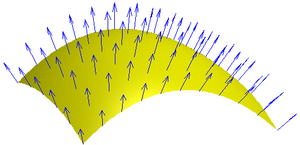მაგნიტური ნაკადი: განსხვავება გადახედვებს შორის
| [შეუმოწმებელი ვერსია] | [შეუმოწმებელი ვერსია] |
No edit summary |
|||
| ხაზი 1: | ხაზი 1: | ||
{{ითარგმნება}} |
{{ითარგმნება}} |
||
'''მაგნიტური ნაკადი''' (როგორც წესი აინიშნება ბერძნული ასო {{ფი_(ასო)|Φ}} აღინიშნება) არის მაგნიტური [[ფიზიკური სიდიდე]], რომელიც აღწერს [[მაგნიტური ველი]]ს ძალასა და კონფიგურაციას რაიმე ზედაპირზე. [[SI სისტემა]]ში მაგნიტური ნაკადის ერთეული არის [[ვებერი_(ერთეული)|ვებერი]], ხოლო [[გაუსის ერთეულთა სისტემა]]ში [[გაუსი_(ერთეული)|გს]] [[სანტიმეტრი|სმ]]<sup>2</sup>. |
|||
'''Magnetic flux''', represented by the Greek letter Φ ([[Phi (letter)|phi]]), is a measure of quantity of [[magnetism]], taking into account the strength and the extent of a [[magnetic field]]. The [[SI]] [[unit of measurement|unit]] of magnetic flux is the [[Weber (unit)|weber]] (in derived units: volt-seconds), and the unit of magnetic field is the weber per square meter, or [[Tesla (unit)|tesla]]. |
|||
==განმარტება== |
|||
==Description== |
|||
[[ |
[[სურათი:Surface integral illustration.png|right|thumb|Figure 1: The definition of surface integral relies on splitting the surface into small surface elements. Each element is associated with a vector d'''S''' of magnitude equal to the area of the element and with direction normal to the element and pointing outward.]] |
||
[[Image:Surface normal.png|right|thumb|300px|Figure 2: A vector field of normals to a surface.]] |
[[Image:Surface normal.png|right|thumb|300px|Figure 2: A vector field of normals to a surface.]] |
||
The [[flux]] through an element of [[area]] [[perpendicular]] to the direction of magnetic field is given by the product of the [[magnetic field]] and the [[area]] element. |
The [[flux]] through an element of [[area]] [[perpendicular]] to the direction of magnetic field is given by the product of the [[magnetic field]] and the [[area]] element. |
||
12:22, 1 აპრილი 2010-ის ვერსია
漢>ა A>ა | ეს სტატია/სექცია ქართულ ენაზე თარგმნის პროცესშია. თუ ფლობთ ამ ენას, თქვენც შეგიძლიათ მონაწილეობის მიღება. |
მაგნიტური ნაკადი (როგორც წესი აინიშნება ბერძნული ასო თარგი:ფი (ასო) აღინიშნება) არის მაგნიტური ფიზიკური სიდიდე, რომელიც აღწერს მაგნიტური ველის ძალასა და კონფიგურაციას რაიმე ზედაპირზე. SI სისტემაში მაგნიტური ნაკადის ერთეული არის ვებერი, ხოლო გაუსის ერთეულთა სისტემაში გს სმ2.
განმარტება


The flux through an element of area perpendicular to the direction of magnetic field is given by the product of the magnetic field and the area element.
More generally, the magnetic flux at any angle to a surface is defined by a scalar product of the magnetic field and the area element vector.
The direction of the magnetic field vector B is by definition from the south to the north pole of a magnet (within the magnet). Outside of the magnet, the field lines will go from north to south.
The magnetic flux through a surface is proportional to the number of magnetic field lines that pass through the surface. This is the net number, i.e. the number passing through in one direction, minus the number passing through in the other direction.
Quantitatively, the magnetic flux through a surface S is defined as the integral of the magnetic field over the area of the surface (See Figures 1 and 2):
where
- is the magnetic flux
- B is the magnetic field,
- S is the surface (area),
- denotes dot product,
- dS is an infinitesimal vector, whose magnitude is the area of a differential element of S, and whose direction is the surface normal. (See surface integral for more details.)
In the special case where the surface S is a planar surface with area A, and the magnetic field is constant with magnitude B, the formula simplifies to
where θ is the angle between B and the surface normal to S.
The magnetic flux is usually measured with a fluxmeter. The fluxmeter contains measuring coils and electronics that evaluates the change of voltage in the measuring coils to calculate the magnetic flux.
Magnetic flux through a closed surface
Gauss's law for magnetism, which is one of the four Maxwell's equations, states that the total magnetic flux through a closed surface is equal to zero. (A "closed surface" is a surface without boundaries, such as the surface of a sphere or a cube, but not like the surface of a disk.) This law is a consequence of the empirical observation that magnetic monopoles have never been found.
In other words, Gauss's law for magnetism is the statement:
for any closed surface S.
ღია ზედაპირის გამჭოლი მაგნიტური ნაკადი

While the magnetic flux through a closed surface is always zero, the magnetic flux through an open surface is an important quantity in electromagnetism. For example, a change in the magnetic flux passing through a loop of conductive wire will cause an electromotive force, and therefore an electric current, in the loop. The relationship is given by Faraday's law:
სადაც (see Figure 3):
- E is the EMF,
- Φm is the flux through a surface with an opening bounded by a curve ∂Σ(t),
- ∂Σ(t) is a closed contour that can change with time; the EMF is found around this contour, and the contour is a boundary of the surface over which Φm is found,
- dℓ is an infinitesimal vector element of the contour ∂Σ(t),
- v is the velocity of the segment dℓ,
- E is the electric field,
- B is the magnetic field.
The EMF is determined in this equation in two ways: first, as the work per unit charge done against the Lorentz force in moving a test charge around the (possibly moving) closed curve ∂Σ(t), and second, as the magnetic flux thorough the open surface Σ(t).
This equation is the principle behind an electrical generator.






